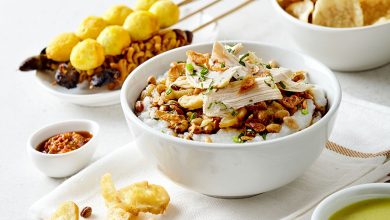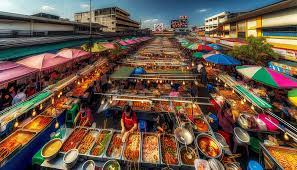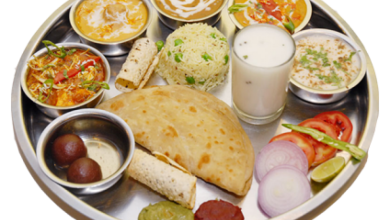A Culinary Journey Through Indonesia: Exploring the Rich Tapestry of Indonesian Cuisine
Indonesian Cuisine

Introduction:
Over 17,000 islands make up the enormous archipelago of Indonesia, which is home to a wealth of gastronomic treasures in addition to a diverse tapestry of cultures and landscapes. The bright tastes, fragrant spices, and variety of influences found in Indonesian cuisine are a reflection of the nation’s rich cultural heritage. This article explores the diverse and mouthwatering world of Indonesian cuisine, taking you on a gastronomic voyage around the country.
Geographical and Cultural Influences:
The unique geography and cultural past of Indonesia have left their mark on the cuisine, which is a veritable melting pot of tastes. Indonesian cuisine is a well-balanced fusion of spices, herbs, and cooking methods, influenced by its many ethnic groups and long history of trading with Indian, Chinese, Arab, and European civilizations. The distinctive foods that are contributed by each area create a gastronomic environment that differs from island to island.
Rice, the Staple Food:
For most people in Indonesia, rice is the main staple meal and the foundation of their cuisine. Rice is served with almost every meal, which is indicative of its cultural importance. A popular dish across the country, aromatic fried rice known as nasi goreng highlights the variety and inventiveness of Indonesian cooking. The variety of ingredients used to prepare nasi goreng—from shrimp to chicken and vegetables—makes it a tasty and adaptable dish.
Satay: A Grilled Delight:
In Indonesia, satay—grilled and skewered meat—is a well-liked street dish. Before being expertly grilled, satay—whether it be chicken (sate ayam), beef (sate sapi), or lamb (sate kambing)—is usually marinated in a flavorful mixture of spices, such as turmeric, coriander, and lemongrass. Satay is a fragrant and savory cuisine that embodies the spirit of Indonesian grilling customs, and it is best served with a side of peanut sauce.
Rendang: A Spicy Culinary Masterpiece:
Renderang is a spicy beef dish that originated with the Minangkabau people of West Sumatra and has become popular all over the world. Renderang is a dish that is often made on special occasions. It is made by slowly simmering beef, chicken, or lamb with coconut milk and a mixture of spicy spices until the meat is soft and the sauce thickens. The outcome is a meal that exemplifies the richness of Indonesian culinary expertise and is rich, delicious, and somewhat sweet.


Sambal: The Heart of Indonesian Heat:
A discussion of Indonesian food would be incomplete without mentioning sambal, the common chile paste that gives many dishes their bite and complexity. Many components, such as shrimp paste, shallots, garlic, and chili peppers, can be used to make sambal. It comes in a variety of regional varieties, each with a distinct umami, acidity, and heat balance. These hot sauces are an essential component of Indonesian cuisine, appearing in dishes like sambal terasi and sambal matah.
Nasi Padang: A Culinary Extravaganza:
The gastronomic feast known as Nasi Padang, which originated in the Padang region of West Sumatra, consists of a wide array of foods served over rice. A diverse selection of aromatic and piquant foods, including rendang, curry, and fried fish, are served to patrons. With this eating arrangement, guests may have a personalized and shared culinary experience while sampling a variety of Indonesian cuisines all at once.
Gado-Gado: A Symphony of Vegetables:
Gado-gado is a vibrant Indonesian salad that mixes hard-boiled eggs, tofu, tempeh, and boiled veggies with a delicious peanut sauce, making it a refreshing and healthful choice for anybody looking for something to eat. For vegetarians and those seeking a light yet filling lunch, gado-gado is a popular option because of its contrast of textures and variety of tastes.
Diversity of Indonesian Sweets:
Indonesian sweets are as varied as the topography of the nation. A delicious rush of flavors may be found in Klepon, a sweet rice cake covered with shredded coconut and filled with palm sugar. Dadar gulung, a green pancake roll stuffed with sweet coconut and palm sugar, is another well-liked dessert. Coconut, pandan leaves, and palm sugar are frequently used in Indonesian sweets, resulting in a harmonious blend of fragrant and sweet treats.


Conclusion:
In summary, the rich history and many cultures of the Indonesian archipelago are reflected in the food, which is a dynamic tapestry of tastes, textures, and fragrances. The richness and diversity of Indonesian cuisine enthralls the palette, from the spicy pleasures of rendang and satay to the cool gado-gado and sweet treats of klepon. Unique dishes are a tribute to Indonesia’s culinary expertise and its capacity to provide an exceptional dining experience for those ready to go on a culinary trip across its various and tasty landscapes, as the country continues to make its imprint on the world culinary arena.


